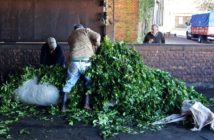China is arguably the spiritual home of tea and, taken with the secrecy that still surrounds the country, holds a particular fascination for me.
Being a complete tea devotee, I felt like a child at Christmas about visiting China in April this year to source some new teas for my business and to meet with existing suppliers.
One of the highlights was visiting oolong tea gardens in Hua’an County, Fujian. I already source oolongs from Fujian but it was seeing the processes involved in making Tie Guan Yin that particularly fascinated me and gave me a real appreciation of the skill and knowledge required to make quality oolongs.
We had a long, white-knuckle car journey (as all car journeys are in China!) deep into the mountains in Hua’an where we met with a very inspiring family who had opened a farm and tea garden in 2003 and have worked very hard to cultivate the land, bringing the tea bushes to prime condition and putting in place vital infrastructure and irrigation systems. They are committed to protecting the environment and have adopted a unique way of planting special trees to avoid insect attacks and it was healthy to see a wide variety of wildlife within the tea bushes.
We spent many hours exploring the tea garden. The term “garden” though is a bit misleading; it actually involved a fair bit of hiking up a mountain! We were then given an extensive lesson in the art of oolong production.
To make good oolongs you must start by having well cared for tea bushes and a Tea Master who is committed to high standards and ethical practices. Next, many hours are spent in the field plucking the three leaves and a bud just as they reach their prime on the bush.
The leaves are immediately withered and then shaken and rolled in bamboo baskets to bruise their edges and encourage oxidation. The leaves are alternately shaken and oxidised for a number of hours until they are just right. Next, they are baked for two minutes and rolled in a muslin-like bag to achieve the desired shape. They are then put back in the oven or dried in baskets over charcoal fires to dry before any remaining twigs are removed. They leave the twigs in during processing otherwise the tea doesn’t ferment properly and the liquor would be bitter.
Finally the oolong is ready for tasting.
Tie Guan Yin oolong is sometimes referred to in China as “desert island tea”, as it cannot be lived without. I have a particular fondness for oolong teas as they can combine the best bits of black and green teas together with a whole special depth of their own. They are a contradiction of flavours that blend together perfectly; light yet full of flavour with an orchid-like fragrance but an unmistakable earthy taste. Experiencing oolong tea in China was an unforgettable experience.
Erica Moore is the founder of eteaket Tea Leaf Experts in Edinburgh, Scotland, UK.


